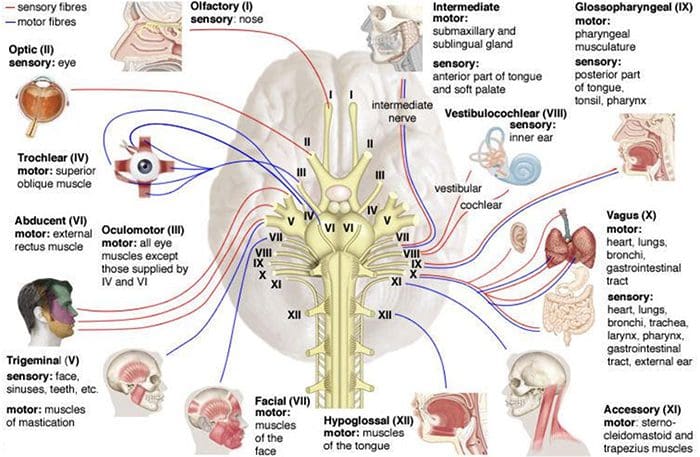The spinal cord and brain comprise the central nervous system, while the spinal nerves (branching to the spinal cord) and cranial nerves (branching to the brain) include the peripheral nervous system.
31 nerves extend out of the spinal cord and are connected to it by the nerve root. Each nerve branches about a half inch from the spinal cord before dividing into smaller branches. The dorsal rami are on the posterior side of the branch, while the larger ventral rami are on the anterior side.

The dorsal rami provides nerve function for the skin of the trunk and posterior muscles. The ventral rami from T1 to T12 provides nerve function to the trunk’s skin and the lateral and anterior muscles.
The anterior divisions that remain for plexuses are networks that provide nerve function to the body. Each plexus has specific areas on the body for skin sensitivity and particular muscles. The point where they exit the spine determines how they are numbered. The four primary plexuses are:
- Cervical plexus, C1 – C4, innervates the diaphragm, shoulder, neck
- Brachial plexus, C5 – T1, innervates the upper limbs
- Lumbar plexus, T12/L1 – L4, innervates the thigh
- The sacral plexus, L4 – S4, innervates the leg and foot.
These spinal nerves have two sets of fibers: motor and sensory. Motor fibers facilitate movement and provide nerve function to the muscles. Sensory fibers facilitate sensitivities to touch, temperature, and other stimuli and provide nerve function to the skin.

Table of Contents
What are Myotomes and Dermatomes?
A group of muscles innervated by motor fibers stemming from a specific nerve root is called a myotome. An area of the skin innervated by sensory fibers stemming from a specific nerve root is called a dermatome. These patterns of myotome and dermatome are almost always identical from person to person. There are occasionally variances, but that is rare.
This consistency allows doctors to treat nerve pain in patients. If a certain area is hurting, they know that it is attributed to a certain myotome or dermatome, whichever the case may be, and its corresponding nerve root. Problems with nerve damage are often the result of stretching the nerve or compressing it.
When nerves are injured in specific areas, such as the lumbosacral or brachial plexus, sensory and motor deficits occur in the limbs that correspond to them. Myotomes and dermatomes are used to assess the extent of the damage.
How are Myotomes and Dermatomes Used to Assess Nerve Damage?

When a doctor tests for nerve root damage in a patient, he or she will often test the myotomes or dermatomes for the nerves assigned to that location. A dermatome is examined for abnormal sensation, such as hypersensitivity or lack of sensitivity.
This is done using stimulus-inducing tools such as a pen, paper clip, pinwheel, fingernails, cotton ball, or pads of the fingers. The patient is instructed to provide feedback regarding their response. Some of the abnormal sensation responses include:
- Hypoesthesia (decreased sensation).
- Hyperesthesia (excessive sensation).
- Anesthesia (loss of sensation).
- Paresthesia (numbness, tingling, burning sensation).
A myotome is tested for muscle nerve damage, which presents as weakness. This grading scale, which assigns a rating to the degree of muscle weakness, is often used:
- 5 – Normal – Complete range of motion against gravity with full resistance
- 4 – Good – Complete range of motion against gravity with some resistance
- 3 – Fair – Complete range of motion against gravity with no resistance, active ROM
- 2 – Poor – Complete range of motion with some assistance and gravity eliminated
- 1 – Trace – Evidence of slight muscular contraction, no joint motion evident
- 0 – Zero – No evidence of muscle contraction

During a typical chiropractic exam, your chiropractor will assess dermatomes and myotomes for potential neurological problems. This gives him or her additional insight into treating your condition, whether related to a subluxation of vertebral bodies or other disease processes.
Back Pain Chiropractic Care
Post Disclaimer
Professional Scope of Practice *
The information on this blog site is not intended to replace a one-on-one relationship with a qualified healthcare professional or licensed physician and is not medical advice. We encourage you to make healthcare decisions based on your research and partnership with a qualified healthcare professional.
Blog Information & Scope Discussions
Welcome to El Paso's Premier Wellness and Injury Care Clinic & Wellness Blog, where Dr. Alex Jimenez, DC, FNP-C, a board-certified Family Practice Nurse Practitioner (FNP-BC) and Chiropractor (DC), presents insights on how our team is dedicated to holistic healing and personalized care. Our practice aligns with evidence-based treatment protocols inspired by integrative medicine principles, similar to those found on this site and our family practice-based chiromed.com site, focusing on restoring health naturally for patients of all ages.
Our areas of chiropractic practice include Wellness & Nutrition, Chronic Pain, Personal Injury, Auto Accident Care, Work Injuries, Back Injury, Low Back Pain, Neck Pain, Migraine Headaches, Sports Injuries, Severe Sciatica, Scoliosis, Complex Herniated Discs, Fibromyalgia, Chronic Pain, Complex Injuries, Stress Management, Functional Medicine Treatments, and in-scope care protocols.
Our information scope is limited to chiropractic, musculoskeletal, physical medicine, wellness, contributing etiological viscerosomatic disturbances within clinical presentations, associated somato-visceral reflex clinical dynamics, subluxation complexes, sensitive health issues, and functional medicine articles, topics, and discussions.
We provide and present clinical collaboration with specialists from various disciplines. Each specialist is governed by their professional scope of practice and their jurisdiction of licensure. We use functional health & wellness protocols to treat and support care for the injuries or disorders of the musculoskeletal system.
Our videos, posts, topics, subjects, and insights cover clinical matters and issues that relate to and directly or indirectly support our clinical scope of practice.*
Our office has made a reasonable effort to provide supportive citations and has identified relevant research studies that support our posts. We provide copies of supporting research studies available to regulatory boards and the public upon request.
We understand that we cover matters that require an additional explanation of how they may assist in a particular care plan or treatment protocol; therefore, to discuss the subject matter above further, please feel free to ask Dr. Alex Jimenez, DC, APRN, FNP-BC, or contact us at 915-850-0900.
We are here to help you and your family.
Blessings
Dr. Alex Jimenez DC, MSACP, APRN, FNP-BC*, CCST, IFMCP, CFMP, ATN
email: coach@elpasofunctionalmedicine.com
Licensed as a Doctor of Chiropractic (DC) in Texas & New Mexico*
Texas DC License # TX5807
New Mexico DC License # NM-DC2182
Licensed as a Registered Nurse (RN*) in Texas & Multistate
Texas RN License # 1191402
ANCC FNP-BC: Board Certified Nurse Practitioner*
Compact Status: Multi-State License: Authorized to Practice in 40 States*
Graduate with Honors: ICHS: MSN-FNP (Family Nurse Practitioner Program)
Degree Granted. Master's in Family Practice MSN Diploma (Cum Laude)
Dr. Alex Jimenez, DC, APRN, FNP-BC*, CFMP, IFMCP, ATN, CCST
My Digital Business Card


